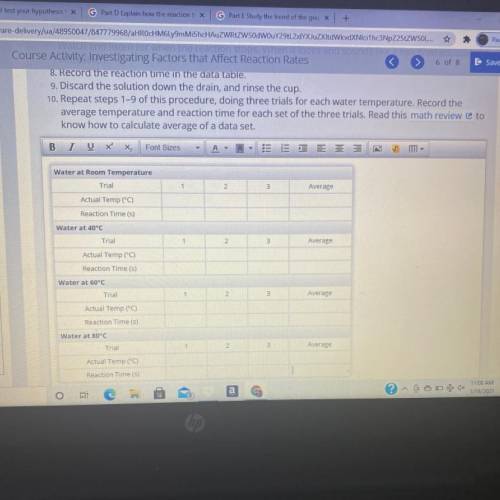
Mathematics, 17.01.2021 01:00 nawafcanada
Next, you'll test your hypothesis from part A by examining the reaction times of vinegar and baking soda
in water at four different temperatures. You'll carry out the reaction using water at room temperature
(about 25°C), 40°C, 60°C, and 80°C. Make sure that you use the same amounts of vinegar and baking
soda for all three three trials.
Gather all the materials, and perform these steps for each trial:
1. Heat at least 1 cup (60 milliliters) of water to the required temperature (refer to the data table).
Water may be heated on a stove, on a hot plate, or in a microwave oven.
2. Measure and record the actual temperature of the water.
3. Measure 1 tablespoon (15 milliliters) of the water into the cup.
4. Add teaspoon (1.5 grams) baking soda to the water, and stir until it is dissolved. The solution will
be clear.
5. Measure 1 tablespoon (15 milliliters) of vinegar, but do not pour it into the cup yet.
6. Very quickly, do all of the following:
a. Pour the measured vinegar into the cup.
b. Start the stopwatch.
C. Stir or carefully swirl the substances in the cup.
7. The chemical reaction will produce bubbles. You'll be able to see the bubbles and hear them pop.
Watch and listen for when the reaction stops. When it looks and sounds like it has finished, stop the
stopwatch.
8. Record the reaction time in the data table.
9. Discard the solution down the drain, and rinse the cup.
10. Repeat steps 1-9 of this procedure, doing three trials for each water temperature. Record the
average temperature and reaction time for each set of the three trials. Read this math review to
know how to calculate average of a data set.


Answers: 1
Another question on Mathematics

Mathematics, 21.06.2019 18:10
Find the value of p for which the polynomial 3x^3 -x^2 + px +1 is exactly divisible by x-1, hence factorise the polynomial
Answers: 2

Mathematics, 21.06.2019 18:30
Write an inequality and solve each problem.for exercises 11 and 12, interpret the solution.
Answers: 1

Mathematics, 21.06.2019 21:00
Suppose that in 2008 , 840,800 citizens died of a certain disease assuming the population of teh country is 399 miliion, what is the mortality rate in units of deaths per 100,000 people?
Answers: 1

Mathematics, 21.06.2019 22:00
The number of calories you burn depends on your weight. a 110-pound person burns 163 calories during 30 minutes of tennis. find the number of calories that a 190-pound person would burn during the same activity, assuming they burn calories at the same rate.
Answers: 1
You know the right answer?
Next, you'll test your hypothesis from part A by examining the reaction times of vinegar and baking...
Questions

Mathematics, 23.02.2021 01:40

History, 23.02.2021 01:40



Mathematics, 23.02.2021 01:40

Mathematics, 23.02.2021 01:40




English, 23.02.2021 01:40


Mathematics, 23.02.2021 01:40

Biology, 23.02.2021 01:40


Biology, 23.02.2021 01:40



Mathematics, 23.02.2021 01:40

Mathematics, 23.02.2021 01:40





